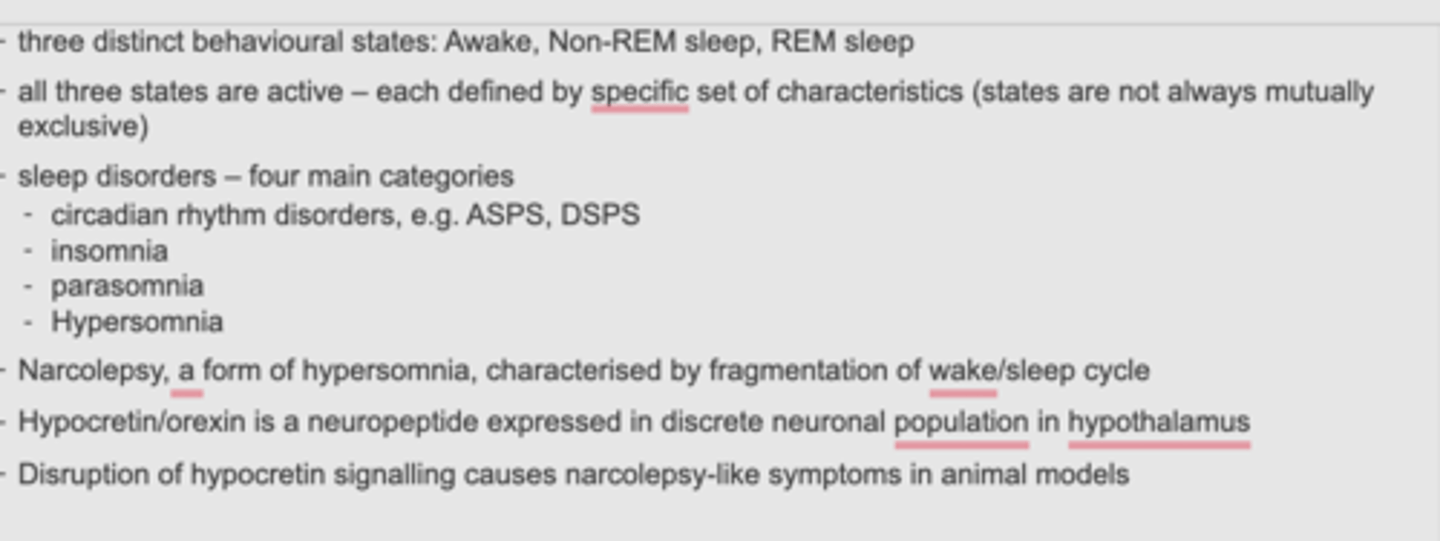Sleep and sleep disorders
1/25
There's no tags or description
Looks like no tags are added yet.
Name | Mastery | Learn | Test | Matching | Spaced |
|---|
No study sessions yet.
26 Terms
Sleep Introduction
- human spends 1/3 of life sleeping
- Sleep requirement changes with age
-sleep is vital behaviour(e.g. laboratory rats)
Sleep stages
-3 main states: Wake state non-REM sleep REM sleep
-characterised by distinct cognitive and conscious experiences
-awake, REM and non-REM sleep are three distinct states, but not always mutually exclusive
Sleep stages EEG characteristics
Wake state alpha (8-12 Hz) and beta waves (>12 Hz)
Non-REM sleep state stage I - theta waves (4-8 Hz)
stage II -
occurrence of sleep spindles
stage III - transition to delta waves (0.5-4 Hz) stage IV enhanced delta wave activity
REM sleep state similar to stage I, can also include beta waves
Sleep associated physiological changes
- regulation of breathing
- cardiovascular control
- muscle tone
- endocrine release
- gastrointestinal
physiology
- convulsive threshold
Sleep wake cycle : two process model
Balance between homeostatic sleep drive and circadian alerting signal controls wake-sleep cycle
Sleep - control
sleep is controlled by: circadian processes (clock-dependent) homeostatic processes (sleep debt-dependent)
The mammalian circadian clock
1. circadian clock is located in superchiasmatic nucleus (SCN), a small discrete nucleus in anterior hypothalamus
2. consists of ~20000 cells
3. controlled by interlocking positive and negative feedback loops involving:
- three period genes
- two cryptochrome genes clock gene
- Bmal1 gene
4. produces ~25 h rhythm
Sleep disorders
1. second most common cause for seeking medical attention
2. almost 100 identified sleep/wake disorders
3. four main categories:
- circadian rhythm disorders
- hypersomnia
- insomnia
- parasomnias
Circadian Rhythm Disorders
1. inability to sleep during the desired sleep time
2. primary: malfunctioning of the biologic clock
- Delayed sleep-phase syndrome (DSPS)
-Advanced sleep-phase syndrome (ASPS)
- Non-24-hour wake-sleep pattern
- irregular wake-sleep pattern
Circadian Rhythm Disorders
1. various genetic causes:
e.g. one form of FASPS (familial ASPS):missense mutation in hPer2 gene (serine to glycine) in recognition site for CKIε resulting in hypo-phosphorylation and increased degradation
other mutations
2. Secondary causes of circadian rhythm disorders:
- environmental effects on biologic clock such as jet-lag and shift work
Circadian Rhythm Disorder Treatments
Phototherapy
Chronotherapy
Chronobiotics : melatonin
Phototherapy
appropriately timed
exposure to bright light
blue light appears especially effective
Chromotherapy
temporal adjustments, e.g. delayed sleep phase syndrome:
progressive shift of sleep time by a few hours every day until desired time is achieved
controlled sleep deprivation with phase advance
Chronobiotics : melatonin
hormone, produced by pineal gland
secretion suppressed by light, secreted during night/sleep
thought to be important factor in circadian and sleep regulation
Catagories of sleep disorders
Insomnia
Parasomnia
Hypersomnia
Insomnia
1. characterised by inability to obtain sleep that is sufficiently long to feel rested
2.causes:
- medical, psychiatric or psychological conditions, some evidence for physiological abnormalities
- insomniacs may be in constant state of hyperarousal
-insomniacs have increased levels of adrenocorticotropic hormone (ACTH) and cortisol secretion
Parasomnia
1. dissociated sleep states, unpleasant experiences or undesirable behaviour during sleep
2.sleepwalking, sleep terrors: admixture of wakefulness and NREM sleep
3. REM sleep behaviour disorder: admixture of wakefulness and REM sleep
Hypersomnia
1. most common cause: voluntary sleep deprivation
~100000 car crashes in the US caused by driving whilst drowsy
2. examples of medical conditions leading to hypersomnia:
- obstructive sleep apnoea, Narcolepsy
Narcolepsy - Hypersomnia with fragmented wake/sleep pattern
1. affects about 1 in 2000 individuals (estimates are quite variable)
2. only neurological disorder characterised by primary disorganisation of sleep and wakefulness
3. narcolepsy sufferers don't sleep more per 24h than unaffected individuals, but are unable to keep normal boundaries between sleep and wakefulness:
- automatic behaviours: mixture of NREM sleep and wakefulness
- cataplexy/sleep paralysis: mixture of REM sleep-related paralysis and wakefulness
Canine model for Narcolepsy
1. cases of muscle atonia and cataplexy have also been described in dogs in response to positive excitation (food, play)
2. cases are sporadic, but there are some inherited cases ➔ establishment of breeding colonies of narcoleptic dogs to study the cause for narcolepsy
What causes canine narcolepsy
- positional cloning project led to isolation of the canine narcolepsy gene in 1999
- canine narcolepsy gene codes for hypocretin receptor 2 (Hcrtr2)
Discovery of hypocretin signalling system
Hypocretin signalling system consists of:
two peptides:
- Hypocretin-1 (Hcrt1; also known as Orexin-A)
- Hypocretin-2 (Hcrt2; also known as Orexin-B)
two receptors:
- Hypocretin-1 receptor (Hcrtr1; also known as Orexin 1 receptor, OX1R)
- Hypocretin-2 receptor (Hcrtr2; also known as Orexin 2 receptor, OX2R)
Hypocretin receptor signalling
Hcrtr1/OX1R is coupled to the Gq signalling pathway and has excitatory functions
Hcrtr2/OX2R is coupled to either Gq or Gi/o and has both excitatory and inhibitory functions
What causes canine narcolepsy
various Hcrtr2 mutations have been shown to be linked to narcolepsy in dogs
Evidence for link between hypocretin signalling and narcolepsy
-Hcrtr1 knockout mice only show mild sleep fragmentation
- Hcrtr2 knockout mice also show cataplexy
- double receptor knock-outs show full narcolepsy-like phenotype
- hypocretin knockout mice also show narcolepsy-like phenotype
Summary
